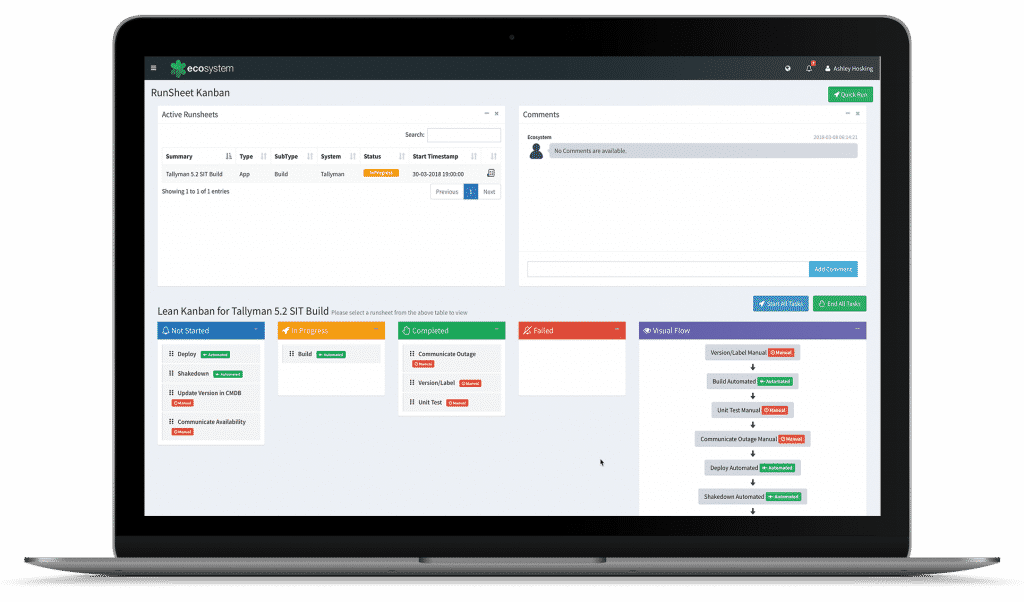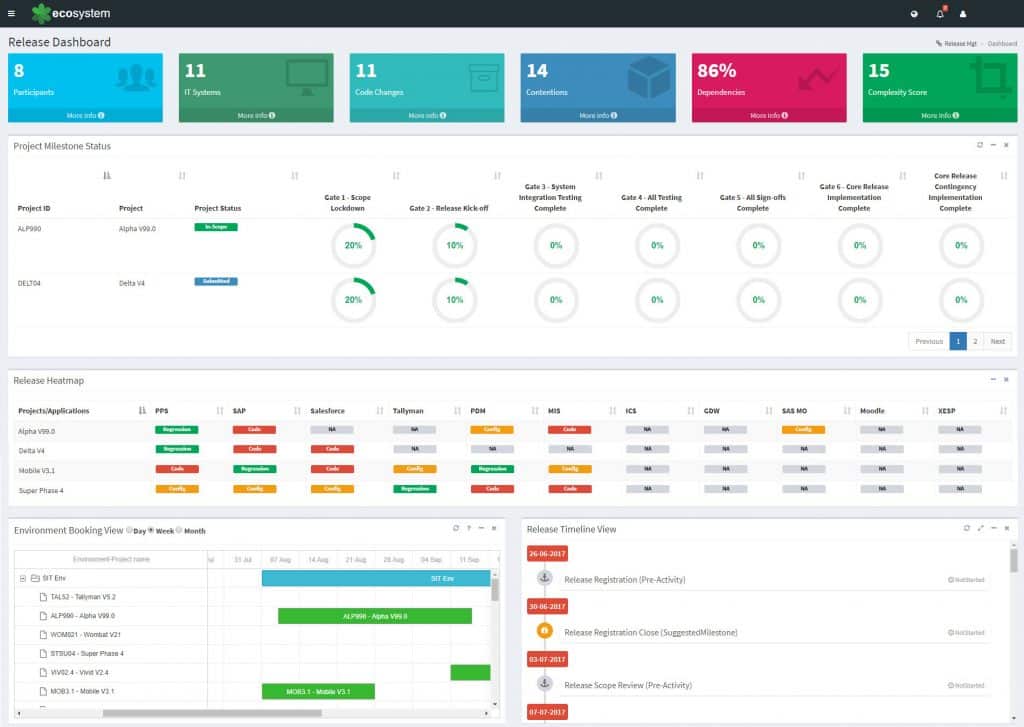Benchmarking Release Management
by Niall Crawford
Digital the Backbone of Business /
It goes without saying, that the backbone of all organizations today is digital and independent of the end-products you provide, there is an inherent need to drive your features and solutions from conception (the initial idea) through to production (the end customer) as quickly, safely and efficiently as possible.
- That is, every organization requires effective IT Release Management.
So, what is IT Release Management? Let us start with a definition (or two):
From Wikipedia:
Release management is the process of managing, planning, scheduling and controlling a software build through different stages and environments; including testing and deploying software releases.
Enterprise release management is a multi-disciplinary IT governance framework for managing software delivery and software change across multiple departments in a large organization.
The former is what a DevOps engineer might gravitate to i.e. someone with the task of building and deploying code to their individual system or services.
And the latter something that might be handled by an Enterprise Release Manager (or Portfolio Manager), that is someone interested in coordinating a family of system/project releases using methods like SAFe (Scaled
A Visual Definition of Release Management
Alternatively, consider the following diagram.

Holistic Release Management is a combination of Vertical Practices responsible for supporting delivery through the system lifecycle (i.e. Analysis, Design, Development, Test, and Implementation), a set of Horizontal Practices responsible for driving transformation across the enterprise (or divisions).
Measuring Release Management
Independent of whether your perspective is vertical (system focused) and/or horizontal (enterprise focused), there is little argument in the importance of getting both activities completed correctly and having the various teams working together as effectively as possible.
However, agreeing on benchmarking may not be trivial as the two tasks, although obviously related, are quite different. With the above in mind, we decided to put together two sets of release metrics that we thought would be useful in providing insight with respect to current release
- The ten best metrics for Enterprise Release Management (ERM)
- The ten best metrics for Release Management (aka System Deployment)
Note: Special thanks to some of our enov8 customers for sharing some of these.
Enterprise Release Management (ERM) Metrics
Whom: Typically, the responsibility of an IT Enterprise Release Manager the main goals are to ensure that a family of project releases (changes), which are often related and contain dependencies, can move through the software development lifecycle, from conception to production, in a controlled and aligned fashion.

Key data & trends, to be captured would be:
- Size of Enterprise Release by Projects (Project Releases Registered)
- Size of Enterprise Release by System Deployments
- Size of Enterprise Release by Features (or Stories)
- Project Releases Status (Success/Failure)
- Project Releases Delivered on Time
- Project Release Delay
- Number of Project De-Scoped*
- Number of Systems De-Scoped*
- Number of Features De-Scoped*
- Root Cause of Project Release Delay
*Note: In Enterprise release management, de-scoping is most typically caused by a project failing to meet its release gate obligations and being removed from the enterprise release as quickly as possible and thus avoid an impending “train crash’.
Release Management (System Deployment) Metrics
Whom – Typically, the responsibility of a DevOps “System Release” Engineer, the main goals are reliability and velocity i.e. the engineer wants to get the job done as safely and quickly as possible.

Key system deployment data & trends would be:
- System Deployment Frequency
- System Deployment Feature (Story) Size
- System Deployment Status (Success/Failure)
- System Deployment Time (ideally versus SLA)
- System Deployment Outage Time (outage time for deployment itself)
- System Post-Deployment Outage Time (outage caused by unsuccessful deployment)
- System Post-Deployment Incidents (Tickets) due to a deployment
- Mean Time to issue detection
- Root Cause of System Deployment Issue (Delay, Incident or Outage)
- Mean Time to remediation
Note: In the case of DevOps you would expect these metrics to be of use across the lifecycle. Therefore, the word ‘System’ could quite logically be replaced with ‘System Instance’, where you would have Instances in Integration, UAT, Staging & Production.
Food for thought
Hopefully, you found some of the above release metrics useful & maybe thought-provoking.
Ultimately metrics need to be aligned with your own operating model.
However, in closing we’d say this:
Good release metrics should always do the following:
- Clarify release strategy i.e. direct good practice
- Understand existing release capability i.e. strengths & weaknesses and
- Drive release enhancement i.e. continuous improvement
What else would you add to the above “Release Management” Metrics?
Further Reading
- Understand the association between Enterprise release management & DevOps:
Ref: ERM – The bridge between corporate strategy & DevOps
- Releases need Environments, Non-Production Environment Metrics:
Ref: Test Environment Management Metrics
Learn More or Share Ideas about Release Management & Enterprise Release Management
If you’d like to learn more about Release Management or perhaps just share your own ideas then feel free to contact the enov8 team. Enov8 provides a complete platform for addressing organizations “DevOps at Scale” requirements. Providing advanced “out of the box” IT & Test Environment Management, Release Management and Holistic Data Management capabilities.
Our Key solutions include
- Environment Manager for IT & Test Environment Management.
- Release Manager for Enterprise Release Management & Implementation Planning.
- Data Compliance Suite (DCS) for Test Data Management, including Data/Risk Profiling /Discovery, Automated Remediation & Compliance Validation.
Niall is the Co-Founder and CIO of Enov8. He has 25 years of experience working across the IT industry from Software Engineering, Architecture, IT & Test Environment Management and Executive Leadership. Niall has worked with, and advised, many global organisations covering verticals like Banking, Defence, Telecom and Information Technology Services.
Relevant Articles
DORA Compliance – Why Data Resilience is the New Digital Battlefield
How Enov8 Helps Financial Institutions Align with the EU's Digital Operational Resilience Act Executive Introduction As of January 2025, the EU's Digital Operational Resilience Act (DORA) has become legally binding for financial institutions operating across the...
Data Fabric vs Data Mesh: Understanding the Differences
When evaluating modern data architecture strategies, two terms often come up: data fabric and data mesh. Both promise to help enterprises manage complex data environments more effectively, but they approach the problem in fundamentally different ways. So what’s...
What Is Release Management in ITIL? Guide and Best Practices
Managing enterprise software production at scale is no easy task. This is especially true in today’s complex and distributed environment where teams are spread out across multiple geographical areas. To maintain control over so many moving parts, IT leaders need to...
Test Environment: What It Is and Why You Need It
Software development is a complex process that requires meticulous attention to detail to ensure that the final product is reliable and of high quality. One of the most critical aspects of this process is testing, and having a dedicated test environment is essential...
PreProd Environment Done Right: The Definitive Guide
Before you deploy your code to production, it has to undergo several steps. We often refer to these steps as preproduction. Although you might expect these additional steps to slow down your development process, they help speed up the time to production. When you set...
What is Data Tokenization? Important Concepts Explained
In today’s digital age, data security and privacy are crucial concerns for individuals and organizations alike. With the ever-increasing amount of sensitive information being collected and stored, it’s more important than ever to protect this data from...






